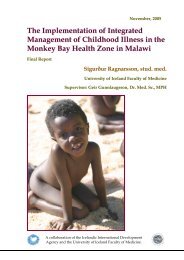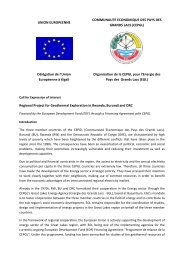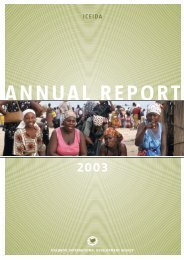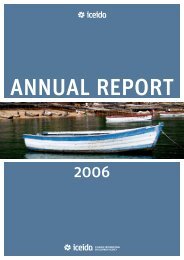Mangochi-ICEIDA-Partnership-in-Public-Health-2012-2016-Part-II ...
Mangochi-ICEIDA-Partnership-in-Public-Health-2012-2016-Part-II ...
Mangochi-ICEIDA-Partnership-in-Public-Health-2012-2016-Part-II ...
You also want an ePaper? Increase the reach of your titles
YUMPU automatically turns print PDFs into web optimized ePapers that Google loves.
MANGOCHI <strong>ICEIDA</strong> PARTNERSHIP IN PUBLIC HEALTH – PROGRAMME DOCUMENT <strong>2012</strong>-<strong>2016</strong><br />
6.9%). This was estimated to represent 64% of all births <strong>in</strong> the district, up from 62% <strong>in</strong> the preced<strong>in</strong>g<br />
year. Namwera (55%) and Makanjira (41%) lag far beh<strong>in</strong>d the other zones <strong>in</strong> this respect and the<br />
performance <strong>in</strong> Makanjira even deteriorated from one year to the next. Furthermore, two cases of<br />
neonatal tetanus were reported <strong>in</strong> Makanjira health centre <strong>in</strong> 2010/2011, the only such cases<br />
reported <strong>in</strong> the district.<br />
Obstetric fatality rate (OFR) is a subset of MMR but it focuses on <strong>in</strong>stitutional deaths (does not take<br />
<strong>in</strong>to account community deaths). OFR is calculated as a ratio of obstetric deaths per 1000 obstetric<br />
complications treated. This parameter depends on quality and completeness of report<strong>in</strong>g obstetric<br />
complications. At least 15% of all pregnancies are estimated to have emergency obstetric<br />
complications. The health service should aim at provid<strong>in</strong>g emergency obstetric care to all women<br />
with obstetric complications. It is recommended that Caesarean sections should not be less than 5%<br />
and not more than 15%. Fall<strong>in</strong>g below 5% means this service is not available even to the needy ones<br />
whereas above 15% can be <strong>in</strong>terpreted as unnecessary operations. (It is important to keep <strong>in</strong> m<strong>in</strong>d<br />
what the denom<strong>in</strong>ator is when <strong>in</strong>terpret<strong>in</strong>g this statistic). In Malawi, the C-section rate has gradually<br />
<strong>in</strong>creased from between 2% and 3% <strong>in</strong> 1992, to 7% <strong>in</strong> 2007 (MoH 2008). In <strong>Mangochi</strong> the proportion<br />
was 6% of deliveries reported <strong>in</strong> health facilities <strong>in</strong> 2010/2011.<br />
The HMIS reported 43 direct <strong>in</strong>patient obstetric deaths <strong>in</strong> 2009/2010. Assum<strong>in</strong>g that 300 maternal<br />
deaths occur <strong>in</strong> <strong>Mangochi</strong> District annually (42,000 live births, MMR 700), clearly the large majority<br />
of maternal deaths occur <strong>in</strong> the community. Assum<strong>in</strong>g that 15,000 births take place out <strong>in</strong> the<br />
villages annually the fatality rate may be roughly ten times higher for home deliveries compared to<br />
deliveries <strong>in</strong> health facilities (or attended by skilled attendants). It must be emphasised however that<br />
this analysis is based on estimates. Due to <strong>in</strong>complete coverage of the village health register<br />
estimates are used rather than count<strong>in</strong>g on rout<strong>in</strong>e demographic data from the field. Here aga<strong>in</strong><br />
HSAs could play an important role.<br />
2.3.2. Control of Communicable and Vector-borne Diseases<br />
2.3.2.1. Malaria<br />
Malaria is a great problem <strong>in</strong> <strong>Mangochi</strong>. It is difficult to make sense of HMIS reports however,<br />
because treatment is given for presumed malaria (fever) and most reported cases are not confirmed.<br />
It is not known what percentage of presumed cases are genu<strong>in</strong>e malaria cases. Nevertheless, there is<br />
little doubt that the malaria parasite takes its toll <strong>in</strong> the district.<br />
The strategies to combat malaria are: <strong>in</strong>termittent preventive treatment for pregnant women, early<br />
case management to reduce mortality, and <strong>in</strong>tegrated vector management namely <strong>in</strong>secticide<br />
treated bed nets (ITN), house to house <strong>in</strong>door residual spray<strong>in</strong>g (IRS) and “larvicid<strong>in</strong>g” (to be<br />
<strong>in</strong>troduced soon). The first two strategies depend for efficiency on sensitisation <strong>in</strong> the community<br />
and <strong>in</strong> this respect health education delivered by HSAs is important. <strong>Mangochi</strong> performs poorly on all<br />
three fronts. MICS/2006 found that the majority of young children and pregnant women and women<br />
with young children did not sleep under a mosquito net. (Women <strong>in</strong> <strong>Mangochi</strong> are known to use the<br />
mosquito nets for fish<strong>in</strong>g off the shores of Lake Malawi.) Furthermore, 38% of young children had<br />
suffered from fever <strong>in</strong> the two weeks preced<strong>in</strong>g the survey but only 20% received any anti-malaria<br />
drug. There is very little residual spray<strong>in</strong>g <strong>in</strong> the district.<br />
2.3.2.2. HIV/AIDS/STI<br />
<strong>Mangochi</strong> is one of the hardest hit districts <strong>in</strong> Malawi as concerns HIV/AIDS. The district comes next<br />
after Lilongwe and Blantyre <strong>in</strong> this respect. The follow<strong>in</strong>g factors are considered to contribute to this<br />
state of affairs:<br />
22
















